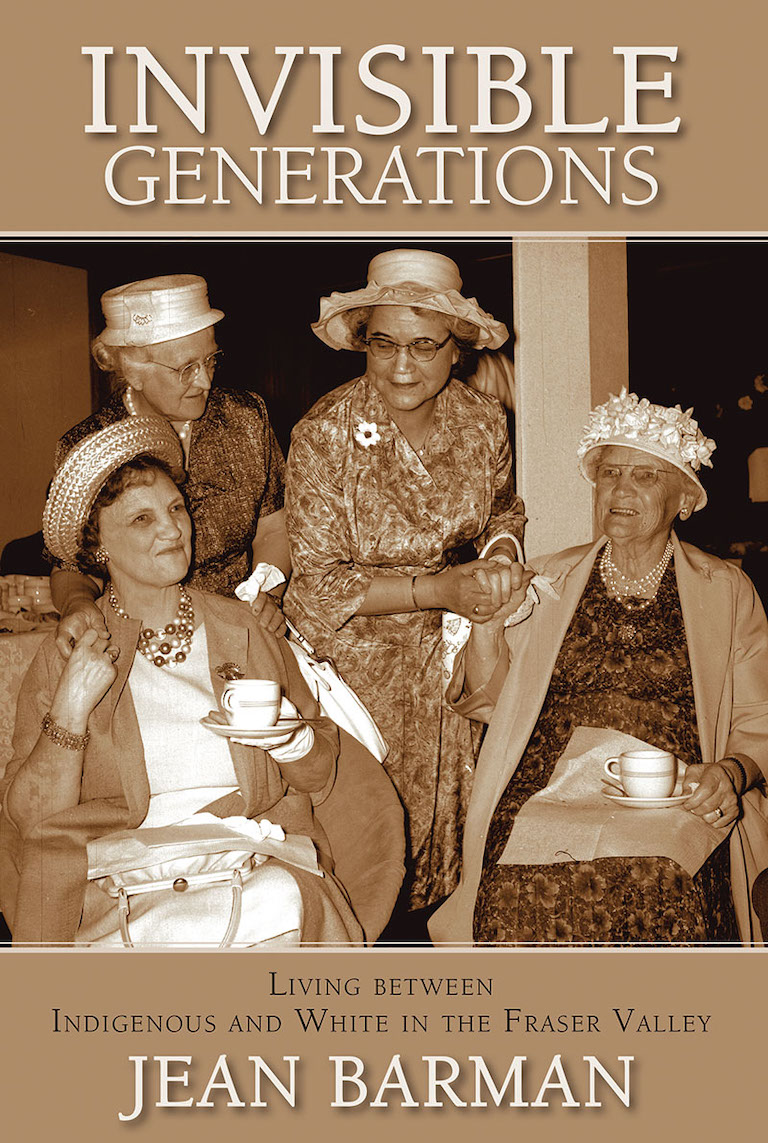Invisible Generations

Invisible Generations: Living Between Indigenous and White in the Fraser Valley
by Jean Barman
Caitlin Press,
176 pages, $24.95
A double review with
Distorted Descent: White Claims to Indigenous Identity
by Darryl Leroux
University of Manitoba Press,
293 pages, $27.95
Two recent books are both about mixed-race identity, but their similarity ends there. While Jean Barman’s Invisible Generations is a gentle story about half-white, half-Indigenous pioneer families in British Columbia taking pride in their once-hidden identities, Darryl Leroux’s Distorted Descent is a scathing critique of white people claiming “métis” status for personal gain.
Together, the books show how the value of having a part-Indigenous identity has changed over time. For Barman’s families in British Columbia’s Fraser Valley, being of “mixed blood” in the nineteenth and much of the twentieth century meant being excluded from jobs, marriages, political office, lands, social status, education, and other spaces reserved for white people. It made sense then to deny their Indigenous heritage.
In the twenty-first century, however, a new phenomenon has emerged: White people all over North America are proudly proclaiming part-Indigenous ancestry, often on the basis of family lore and questionable DNA tests. For instance, American Democratic Senator Elizabeth Warren had to walk back unsupported claims about being part-Cherokee. Leroux cites a CBC investigation in which a dog’s DNA was sent for ancestral tracing. “It turned out that Snoopy, the man’s chihuahua, had 20 percent Native American ancestry.”
There is a long history of white people taking on an Indigenous identity to obtain spiritual or metaphysical transformation. However, the “race shifters” Leroux describes have more material goals. Some hope to obtain a Métis citizenship card, which allows access to education funding, hunting and fishing rights, and other benefits. Others use identity to oppose the rights of recognized Indigenous people.
Leroux, an associate professor in the Department of Social Justice and Community Studies at Saint Mary’s University in Halifax, shines light on two groups in Quebec that have been using their newly acquired mixed-race identity to oppose Indigenous land claims (sometimes under the mistaken impression that land claims lead to the expropriation of private property) and to oppose hunting and fishing rights by recognized Indigenous nations. Members of these groups formerly identified as white but changed their tactics following a 2003 Supreme Court of Canada decision that supported the Métis identity of two northern Ontario hunters. The groups saw that “métis” status would give them more traction in their fight.
Leroux makes a distinction between legitimate western Métis (capitalized) and eastern “métis” (not capitalized and used within quotation marks). The latter, says Leroux, almost always base their claim on a single Indigenous ancestor from the seventeenth century.
Contrary to popular belief, very few Indigenous women married Frenchmen in the colonial era. Remarkably, “the same three or four Indigenous women married prior to 1660 are the primary basis for almost all the claims to indigeneity on the [Quebec genealogical] forums,” writes Leroux.
His research reveals some odd patterns: Some “Indigenous” female ancestors have turned out to be European; the same ancestor is sometimes described as Innu, sometimes as Abenaki, sometimes as Mi’kmaq, and sometimes otherwise; a suspicious number of these ancestor women are said to be the daughters of famous chiefs; and everyone wants to be descended from Métis leader Louis Riel, who had no grandchildren.
The author’s position will no doubt rankle some of his fellow white French Canadians: “Our belief that we are the only legitimate victims of [British] colonialism continues to be a major stumbling block to building a meaningful social movement dedicated to combatting French descendant forms of racism and colonialism.”
Distorted Descent is a brave and necessary work. Not everyone will digest Leroux’s dense genealogical research, but readers may come to appreciate the harm the race-shifting movement has done to Indigenous people.
Invisible Generations is a carefully written book anchored in the author’s friendship with Irene Kelleher (1901–2004), a mixed-race schoolteacher. Barman, a pre-eminent historian of British Columbia, got to know Kelleher in the 1990s. Through many interviews and extensive archival research, Barman pieced together a profile of Kelleher and her extended family, especially her parents, her grandparents, and some of their friends and acquaintances. These generations were part of the fur trade, the gold rush, and the settlement of the province.
In the early years, it was acceptable and not uncommon for newly arrived white men in British Columbia to partner with Indigenous women. Some, including the provincial politician Thomas Basil Humphreys, would later abandon their Indigenous spouses and marry white women as a way of moving up in the world. Mixed marriages were eventually discouraged.
“For Irene, as for her parents, the burden of mixed descent, of being a ‘half-breed,’ was ever-present,” writes Barman. Blatant racism was the norm. Kelleher, for instance, never married because “nobody would have me.” A newly arrived young female schoolteacher in remote communities in the 1920s would normally be the belle of the ball at local dances; but, said Kelleher, “they didn’t ask me to dance. I was a half-breed, I didn’t belong.”
She and the others profiled in this book come across as determined, hard-working, resilient, resourceful, and dignified, despite the challenges of poverty, racism, and the reality of being treated as second-class citizens. In the end, Kelleher’s family members emerge as well-regarded, moderately prosperous, and quietly proud of their mixed heritage.
Barman’s book is a call to recognize the contributions of people who have largely been written out of the historical record. Says Barman: “While we cannot undo the past, we can learn from it and behave as best we can towards each other.”
Themes associated with this article
Advertisement




